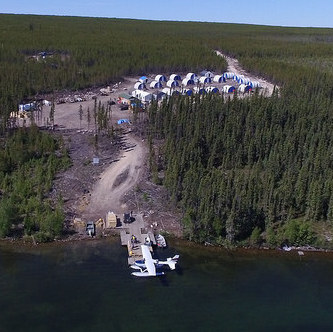NexGen Energy reports positive uranium results in northern Saskatchewan

Aerial view of the Rook 1 camp. — Photo courtesy NexGen Energy NexGen Energy Ltd recently reported radioactivity results from nine holes at its summe
Aerial view of the Rook 1 camp. — Photo courtesy NexGen Energy
NexGen Energy Ltd recently reported radioactivity results from nine holes at its summer 2015 drilling program on the company's 100-percent-owned Rook I property in the Athabasca Basin in northern Saskatchewan.
According to a NexGen announcement, multiple drill holes have intersected substantial off-scale radioactivity at its Arrow Zone, the company's flagship asset.
Hole AR-15-59c2 has intersected dense accumulations of massive and semi-massive pitchblende 130 metres southwest of AR-15-44b in the A2 high-grade shear.
The Vancouver-based company says the hole has expanded the known extents of the higher grade sub-zone in the A2.
NexGen's 30,000-metre summer 2015 drill program is focused on continuing to define the higher-grade sub-zone in the A2 and infilling the A2 through A4 southwest extensions of Arrow.
“We plan to continue drilling until the end of October and then start drilling again in January,” said NexGen corporate development manager Travis McPherson.
McPherson says the company has enough financing to drill 50,000 metres in 2016.
“NexGen is well financed, with about $20 million in the bank,” he said.
In 2016, the company hopes to publish a NI 43-101 resource estimate report (“in the first or second quarter”) and to begin environmental baseline monitoring studies which will provide a basis for its permit application.
“We expect to have a pre-feasibility study completed by 2017,” McPherson said.
In addition to Rook I, NexGen has other properties.
For example, the company made the Bow discovery, 3.7kms northeast of Arrow.
That project is in the early stages of its development.
NexGen also holds an option to earn an initial 70-percent-interest in the Radio project, which is located on trend with Rio Tinto's Roughrider uranium deposit.
Additionally, the company holds a 100-percent-interest in the Thorburn Lake project, which is located southwest of the Radio property and seven kilometres east of Cameco Corporation's Cigar Lake mine.
NexGen was created in 2011.
“Leigh Curyer [company founder and chief executive officer] looked at more than 200 properties in the Athabasca basin and selected the most promising ones, the ones with the most science behind them,” said McPherson. “The Rook I claims comprise the largest single land position held by any company in the southwest part of the Athabasca Basin.”
McPherson says NexGen is looking to develop a mine at Arrow.
“The company certainly has enough experience,” he said.
McPherson says that, although uranium is currently selling at a low price, it is still one of the best performing commodities.
“And Japan is starting up its reactors again, which should help support the price of uranium,” he said.
The Athabasca Basin is reputed to be the highest-grade uranium district in the world. Exploration there resulted in the discovery of such high-grade uranium deposits as Rabbit Lake, Cluff Lake and Key Lake in the late 1960s. Mines there started production in 1975, 1980 and 1983 respectively.
Until 2000, the three mines accounted for most of Canada's uranium production.
At the present time, however, Cameco's McArthur River mine, accounting for 13 percent of global production, is the single largest uranium producer in the world.
Canada is the second-largest uranium producer in the world. The largest producer is Kazakhstan. Other important uranium producers are Niger, Russia and Uzbekistan.
What is a basement-hosted deposit?
When being in the basement is to be on top Arrow is what is called a basement-hosted deposit. According to NexGen, such deposits are some of the most technically simple and economical mines in the uranium sector.
Many Athabasca Basin mines have run into technical problems. Mining such deposits typically requires freezing the surrounding rock underground in order to stabilize the ore body for extraction.
This can add significantly to costs and diminish overall returns.
Any development of Arrow, however, is not expected to require any costly and technically challenging freezing because it is hosted completely in the basement rock.
When being in the basement is to be on top Arrow is what is called a basement-hosted deposit. According to NexGen, such deposits are some of the most technically simple and economical mines in the uranium sector.
Many Athabasca Basin mines have run into technical problems. Mining such deposits typically requires freezing the surrounding rock underground in order to stabilize the ore body for extraction.
This can add significantly to costs and diminish overall returns.
Any development of Arrow, however, is not expected to require any costly and technically challenging freezing because it is hosted completely in the basement rock.




